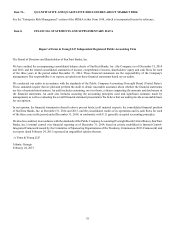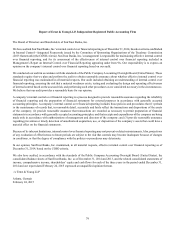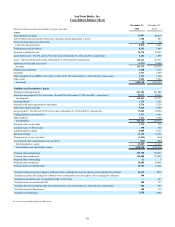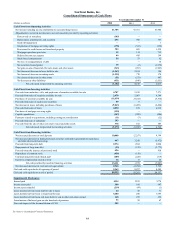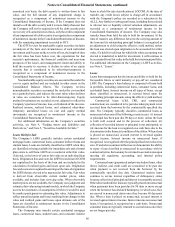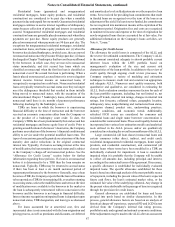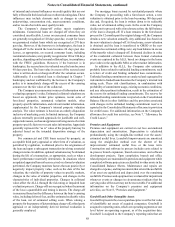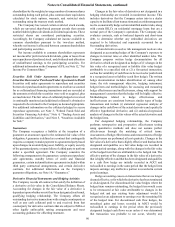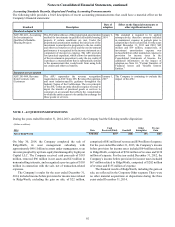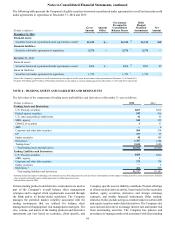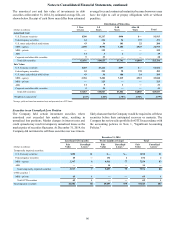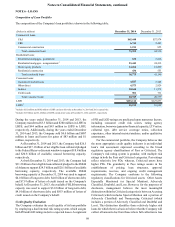SunTrust 2014 Annual Report Download - page 111
Download and view the complete annual report
Please find page 111 of the 2014 SunTrust annual report below. You can navigate through the pages in the report by either clicking on the pages listed below, or by using the keyword search tool below to find specific information within the annual report.Notes to Consolidated Financial Statements, continued
88
of internal and external influences on credit quality that are not
fully reflected in the historical loss or other risk rating data. These
influences may include elements such as changes in credit
underwriting, concentration risk, macroeconomic conditions,
and/or recent observable asset quality trends.
The Company’s charge-off policy meets regulatory
minimums. Commercial loans are charged off when they are
considered uncollectible. Losses on unsecured consumer loans
are generally recognized at 120 days past due, except for losses
on guaranteed student loans which are recognized at 270 days
past due. However, if the borrower is in bankruptcy, the loan is
charged-off in the month the loan becomes 60 days past due.
Losses, as appropriate, on secured consumer loans, including
residential real estate, are typically recognized at 120 or 180 days
past due, depending on the loan and collateral type, in compliance
with the FFIEC guidelines. However, if the borrower is in
bankruptcy, the secured asset is evaluated once the loan becomes
60 days past due. The loan value in excess of the secured asset
value is written down or charged-off after the valuation occurs.
Additionally, if a residential loan is discharged in Chapter 7
bankruptcy and not reaffirmed by the borrower, the Company's
policy is to immediately charge-off the excess of the carrying
amount over the fair value of the collateral.
The Company uses numerous sources of information when
evaluating a property’s value. Estimated collateral valuations are
based on appraisals, broker price opinions, recent sales of
foreclosed properties, automated valuation models, other
property-specific information, and relevant market information,
supplemented by the Company’s internal property valuation
analysis. The value estimate is based on an orderly disposition
inclusive of marketing costs. In limited instances, the Company
adjusts externally provided appraisals for justifiable and well-
supported reasons, such as an appraiser not being aware of certain
property-specific factors or recent sales information. Appraisals
generally represent the “as is” value of the property but may be
adjusted based on the intended disposition strategy of the
property.
For commercial and CRE loans secured by property, an
acceptable third party appraisal or other form of evaluation, as
permitted by regulation, is obtained prior to the origination of
the loan and upon a subsequent transaction involving a material
change in terms. In addition, updated valuations may be obtained
during the life of a transaction, as appropriate, such as when a
loan's performance materially deteriorates. In situations where
an updated appraisal has not been received or a formal evaluation
performed, the Company monitors factors that can positively or
negatively impact property value, such as the date of the last
valuation, the volatility of property values in specific markets,
changes in the value of similar properties, and changes in the
characteristics of individual properties. Changes in collateral
value affect the ALLL through the risk rating or impaired loan
evaluation process. Charge-offs are recognized when the amount
of the loss is quantifiable and timing is known. The charge-off
is measured based on the difference between the loan’s carrying
value, including deferred fees, and the estimated realizable value
of the loan, net of estimated selling costs. When valuing a
property for the purpose of determining a charge-off, a third party
appraisal or an independently derived internal evaluation is
generally employed.
For mortgage loans secured by residential property where
the Company is proceeding with a foreclosure action, a new
valuation is obtained prior to the loan becoming 180 days past
due and, if required, the loan is written down to its realizable
value, net of estimated selling costs. In the event the Company
decides not to proceed with a foreclosure action, the full balance
of the loan is charged-off. If a loan remains in the foreclosure
process for 12 months past the original charge-off, the Company
obtains a new valuation annually. Any additional loss based on
the new valuation is charged-off. At foreclosure, a new valuation
is obtained and the loan is transferred to OREO at the new
valuation less estimated selling costs; any loan balance in excess
of the transfer value is charged-off. Estimated declines in value
of the residential collateral between these formal evaluation
events are captured in the ALLL based on changes in the house
price index in the applicable MSA or other market information.
In addition to the ALLL, the Company also estimates
probable losses related to unfunded lending commitments, such
as letters of credit and binding unfunded loan commitments.
Unfunded lending commitments are analyzed and segregated by
risk similar to funded loans based on the Company’s internal risk
rating scale. These risk classifications, in combination with
probability of commitment usage, existing economic conditions,
and any other pertinent information, result in the estimation of
the reserve for unfunded lending commitments. The reserve for
unfunded lending commitments is reported on the Consolidated
Balance Sheets in other liabilities and the provision associated
with changes in the unfunded lending commitment reserve is
reported in the Consolidated Statements of Income in provision
for credit losses. For additional information on the Company's
allowance for credit loss activities, see Note 7, “Allowance for
Credit Losses.”
Premises and Equipment
Premises and equipment are carried at cost less accumulated
depreciation and amortization. Depreciation is calculated
predominantly using the straight-line method over the assets’
estimated useful lives. Leasehold improvements are amortized
using the straight-line method over the shorter of the
improvements' estimated useful lives or the lease term.
Construction and software in process includes costs related to
in-process branch expansion, branch renovation, and software
development projects. Upon completion, branch and office
related projects are maintained in premises and equipment while
completed software projects are reclassified to other assets in the
Consolidated Balance Sheets. Maintenance and repairs are
charged to expense, and improvements that extend the useful life
of an asset are capitalized and depreciated over the remaining
useful life. Premises and equipment are evaluated for impairment
whenever events or changes in circumstances indicate that the
carrying value of the asset may not be recoverable. For additional
information on the Company’s premises and equipment
activities, see Note 8, “Premises and Equipment.”
Goodwill and Other Intangible Assets
Goodwill represents the excess purchase price over the fair value
of identifiable net assets of acquired companies. Goodwill is
assigned to reporting units, which are operating segments or one
level below an operating segment, as of the acquisition date.
Goodwill is assigned to the Company’s reporting units that are


